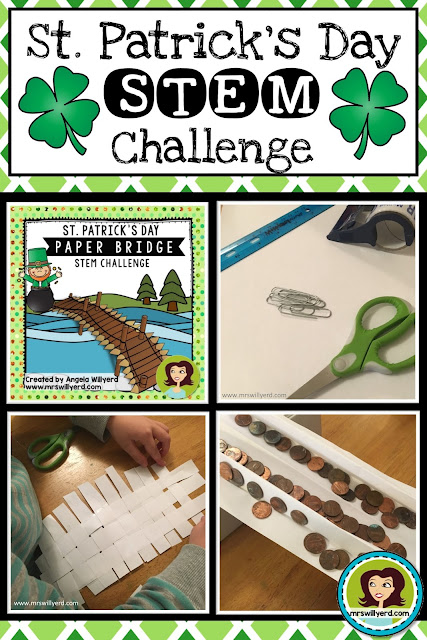You can still celebrate St. Patrick's Day while making the experience fun and educational for your students. It is definitely a win-win situation for all involved!
Plus, if you have a spring break scheduled around this time, a STEM Challenge would be a perfect activity to work into your plans to help keep students on task once you've wrapped up other coursework.
How does this St. Patrick's Day STEM Challenge work?
This St. Patrick's Day Paper Bridge STEM Challenge asks the students to create a paper bridge that will hold 100 pennies for 30 seconds to help the leprechaun transfer his gold coins to the bank.
The new bridge must be made out of a limited amount of common household / classroom materials and completed with a certain amount of time.
Students will go through the STEM design process to create the leprechaun's new bridge. The students will then test the bridge prototypes using pennies (or anything else you may have handy - like unifix cubes or washers). Students will then make improvements to the bridge after the first trial to yield a stronger bridge for the second trial.
 |
| STEM Challenge Preview for Grades 3-5 |
Your classroom will be buzzing with organized chaos as students collaborate on their designs! It is always interesting to observe, as a facilitator, how the students are working together and which "roles" the students choose to take within the challenge.
So, what should this paper bridge look like?
The great thing about a STEM Challenge is that there is not a cookie cutter "right answer" for the students to create.
The students will amaze you with their creativity! Often times, the students design prototypes that adults would never imagine from the limited amount of supplies provided within the challenge.
How do you measure the success of a STEM Challenge?
Of course, it is fun to cheer on the students to design the best prototype that will "win" the challenge.
But, as a teacher, the activity is a success when you observe your students actively following the STEM Design Process steps.
You see them critically thinking, creating, and analyzing the prototype's performance and design when troubleshooting. Students have been activating those higher levels of thinking while having a wonderful time!
Do you love this activity but don't have the time to design it yourself?
A student handout, corresponding presentation, and detailed lesson plan is available in my TeachersPayTeachers store for grades 3-5 and grades 5-8 in either PowerPoint or SMART Notebook formats!
 |
| Click to Shop Now! |











No comments:
Post a Comment